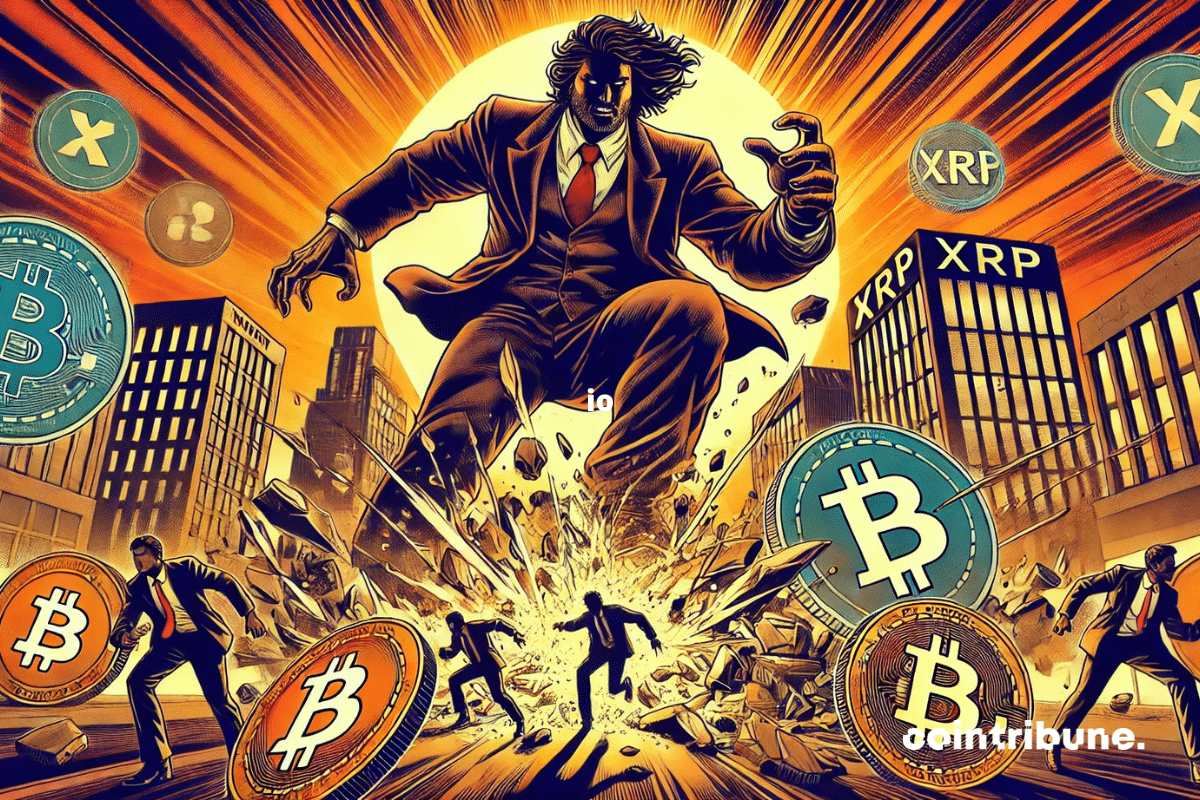The economic confrontation between the United States and China is taking on a new dimension. Indeed, far from being limited to traditional exchanges, this trade war is now affecting the crypto market. Thus, between Donald Trump's announcement regarding the creation of a national strategic reserve of cryptocurrencies and the Chinese response to American economic sanctions, investors are witnessing market movements of rare intensity. The question now arises: is this instability temporary or should we expect a lasting impact?
Home » Archives for Luc Jose Adjinacou » Page 11
Luc Jose A.
Diplômé de Sciences Po Toulouse et titulaire d'une certification consultant blockchain délivrée par Alyra, j'ai rejoint l'aventure Cointribune en 2019. Convaincu du potentiel de la blockchain pour transformer de nombreux secteurs de l'économie, j'ai pris l'engagement de sensibiliser et d'informer le grand public sur cet écosystème en constante évolution. Mon objectif est de permettre à chacun de mieux comprendre la blockchain et de saisir les opportunités qu'elle offre. Je m'efforce chaque jour de fournir une analyse objective de l'actualité, de décrypter les tendances du marché, de relayer les dernières innovations technologiques et de mettre en perspective les enjeux économiques et sociétaux de cette révolution en marche.
As the crypto market goes through a turbulent period, an unexpected asset is drawing all the attention. In an environment marked by widespread losses, Pi Network has just dethroned Hedera (HBAR) in market capitalization, rising to 11th place in the crypto rankings. This turnaround raises questions, both about the drivers of this ascent and the sustainability of the phenomenon. Amid the collapse of giants like Bitcoin, Ethereum, and Solana, how is Pi Coin managing to show gains?
The euphoria of the last few weeks has abruptly transformed into a debacle for crypto investors. In just 24 hours, over a billion dollars worth of positions were liquidated, taking with them the hopes of a prolonged market rebound. At the heart of this shock is a new wave of economic uncertainties, amplified by the United States' decision to impose 25% tariffs on Canada and Mexico. This announcement triggered a sudden drop in traditional markets, as well as a collapse of Bitcoin and major cryptocurrencies.
Oil markets have been caught off guard. While traders expected a delay in the increase of oil production by OPEC+, the cartel ultimately confirmed that it would return 2.2 million barrels per day to the market starting in April. This decision immediately triggered a brutal price reaction: Brent crude fell to $70.60, its lowest level in five months. This strategic choice, which comes after several successive delays, profoundly alters the balance of supply and demand in an already uncertain economic context.
The economic clash between the Global South and the United States is taking a new turn, with Brazil emerging as a key player in this monetary battle. By opposing the supremacy of the US dollar, the Latin American country is redefining global financial balances and questioning the traditional architecture of international trade. This decision is part of a process of dedollarization, which is gaining momentum within the BRICS and could deeply modify international economic circuits.
Crypto markets are often shaken by political announcements, but rarely with such intensity. Donald Trump, the President of the United States, unveiled an unprecedented project: the creation of a national strategic crypto reserve. Indeed, in an environment where the regulation of these assets in the United States remains a hot topic, this announcement triggered a spectacular surge in the market, with Bitcoin briefly surpassing $95,000. However, behind this frenzy, major uncertainties remain. The project still needs to pass through Congress, and some experts are questioning its real feasibility and lasting impact. Between hope and caution, the crypto community remains suspended over the evolution of this matter.
Financial markets often evolve in line with political decisions, and the crypto universe is no exception. This Sunday, Donald Trump rekindled investors' attention by announcing that his crypto reserve project would include several major assets, including XRP, Solana, and Cardano. Initially, bitcoin seemed absent from this list, raising doubts about the former president's stance on it. A quick adjustment then corrected this, as he stated that bitcoin and Ethereum would obviously be included. This turnaround triggered a surge of optimism and a price spike, but the enthusiasm was short-lived. Within less than 24 hours, the market reversed. The cause was the growing concerns about the tariffs that Trump plans to impose, which rekindles fears of economic instability.
Cryptocurrencies go through cycles of euphoria and doubt, where some projects disappear as quickly as they appeared. However, after six years of development, Pi Network has finally launched its native token, generating unprecedented enthusiasm among investors and market observers. Between promises of massive adoption and regulatory uncertainty, the asset today evolves in a volatile environment where every movement is closely scrutinized. While PI has recorded spectacular growth since its introduction, forecasts for March 2025 suggest a possible surge.
Amid revolutionary announcements, technological advancements, and regulatory turbulence, the crypto ecosystem continues to prove that it is both a territory of limitless innovations and a battleground of regulatory and economic challenges. Here is a summary of the most significant news from the past week surrounding Bitcoin, Ethereum, Binance, Solana, and Ripple.
The debate about the future of fiat currencies and the rise of cryptocurrencies is intensifying. As the United States faces sustained inflation and record debt, some experts are questioning the viability of the traditional financial system. Robert Kiyosaki, entrepreneur and author of the bestseller "Rich Dad Poor Dad", has never hidden his skepticism towards the US dollar. He has once again reignited the debate, labeling the American currency as a "scam". Furthermore, he claims that Bitcoin represents the future. His statements, although extreme for some, resonate with many investors concerned about monetary instability and loss of purchasing power.
The crypto market is experiencing a spectacular surge following an unexpected announcement from U.S. President Donald Trump. With the formalization of the establishment of a strategic crypto reserve, a national fund aimed at holding several major cryptocurrencies, he has triggered a massive wave of buying in the market. Investor enthusiasm has pushed some assets to unprecedented levels in weeks, with Cardano (ADA), XRP, and Solana (SOL) leading the most significant gains. However, behind the market euphoria, this initiative also raises criticism and questions regarding its motivations and real implications.
The cryptocurrency market has just experienced one of the most spectacular increases in its history. In just four hours, more than $330 billion was injected, causing a shockwave throughout the entire sector. This sudden explosion of liquidity raises many questions: is it an institutional influx, a speculative event, or a paradigm shift in the economy? What are the implications for investors and the industry? While volatility remains the driving force of the crypto ecosystem, this episode could very well mark a major turning point.
The global economy is evolving under the pressure of increasing trade tensions. As the United States imposes new tariffs, Europe finds itself facing a strategic dilemma. Balancing its traditional alliances and diversifying its economic partnerships, the continent is now looking towards the BRICS. This organization, once seen as a counterweight to the G7, is today consolidating its position by forging closer ties with Europe. This shift could redefine the economic and political power dynamics on a global scale.
The past few weeks have been tough for crypto investors. Indeed, they have been marked by a prolonged market downturn and a growing sense of distrust. Bitcoin, the engine of the sector, has nonetheless recorded a spectacular rebound. Thus, it surpassed $84,000 after having dropped to as low as $78,248. This turnaround raises an essential question: is this a true signal of recovery or just a brief surge before a new phase of turbulence? In the shadow of this rise, major altcoins like Ethereum (ETH), Solana (SOL), and XRP have experienced mixed performances. Some may take this opportunity to regain ground, while others remain under pressure.
The crypto market has just experienced one of its most violent downturns in months. After reaching an all-time high of $109,000 on January 20, Bitcoin plummeted by 28%. This drop wiped out billions of dollars in market capitalization in a matter of weeks. Such a brutal reversal comes amid an environment of economic tension and turmoil in the financial markets. But beyond a mere technical correction, several major events contributed to this decline. From macroeconomic fears, record cyberattacks, to political disillusionment, let's look back at the causes of this tumble and its implications.














